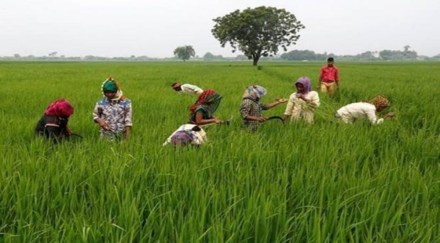By Ashok Gulati & Reena Singh
Against the ‘carbon neutrality by 2070’ target set by India at CoP26, Budget FY23 lists “climate action” and “energy transition” as priorities for the “Amrit Kaal”. The announcement of an additional allocation of Rs 19,500 crore for solar PV modules, co-firing of 5-7% of biomass pellets in thermal power plants, “sovereign green bonds, and “battery-swapping policy” was made in the context. These are steps towards making energy and transport sector less polluting.
But in the case of agriculture, Budget announcements have been rather limited. We know that agriculture contributes 73% of country’s total methane emissions. India has kept itself away from recent EU-US pledge to cut methane emissions by 30% by 2030, despite it being the third-largest emitter of methane globally. It is in this context, one has to see the Budget announcement of chemical-free natural farming within a 5-km-wide corridor along the Ganga, support for millets, increased domestic production of oilseeds, kisan drones, etc. While these are welcome steps, they do not give enough comfort on overcoming the environmental damage already done by this sector as a result of subsidies on urea, canal irrigation, and power for irrigation, along with minimum support prices (MSP) and procurement policies that are concentrated in a few states and largely on two crops, rice and wheat.
On January 1, the country had stocks of wheat and rice in the central pool that were 4X higher than the buffer stocking norms. In fact, rice stocks with the FCI are an astounding 7X higher than the buffer norms. This is despite record distribution of rice in PDS and record exports of rice (17.7MMT) in 2020-21! The financial value of these excessive grain stocks is Rs2.14 lakh crore, out of which Rs 1.66 lakh crore is just because of the excess rice stocks, estimated at economic cost of rice and wheat as given by FCI. Interestingly, the Economic Survey 2021-22, pegs the economic cost of rice and wheat as being higher than those reported by FCI. If one uses Economic Survey costs, then the value of excess stocks jumps to Rs 2.56 lakh crore, with rice accounting for approximately Rs 2 lakh crore.
It is not just inefficient use of scarce capital locked up, the excess stocks are also reflective of a large quantum of greenhouse gases (GHG) embedded. As per the national GHG inventory, agriculture emits 408 million tonnes (mt) of carbon-dioxide equivalent (CO2e), and rice cultivation is the third-largest source (at 17.5%) within Indian agriculture, after enteric fermentation (54.6%) and fertiliser use (19%). Paddy fields are anthropogenic sources of atmospheric nitrous oxide and methane—273 and 80-83 times more powerful than CO2 in driving temperature increase in 20 years, respectively. The amount of methane emitted from paddy fields of India is 3.396 teragram per year, which is 71.32 mt CO2e.
Two important points need to be noted here: First, India is not reporting nitrous oxide emissions in its national GHG inventories. There is scientific evidence that intermittent flooding reduces water and methane emissions, but increases nitrous oxide emissions. Thus, lowering methane emissions through controlled irrigation does not necessarily mean net low emissions. Second, there are emissions due to burning of rice residues, application of fertilisers, production of fertilisers for rice, energy operations like harvesting, pumps, processing, transportation, etc, which are not being accounted in GHG emissions by rice production. A study by Vetter et al (2017) used Cool Farm Tool (CFT) model to estimate annual GHG emissions associated with crops, from production to the farm gate. This study reported emission of 5.65 kg CO2e GHG per kg of rice. Furthermore, rice cultivation requires about 4,000 cubic metres of water per tonne. Even if half of this percolates back to the ground, the excess stocks of 46 mt of rice embed about 92 billion cubic metres of water as well as 260 mt CO2e. According to the IMF, the world needs a global carbon tax of $75 per tonne by 2030 to reduce emissions to a level consistent with a 2°C warming target. India does not have an explicit carbon-price yet, but many countries have instituted carbon pricing, with Sweden leading the pack, at as high a rate as $137 per tonne of CO2e while the EU is at $50/t of CO2e. It is high time that India announced indicative carbon pricing and create a vibrant carbon market to incentivise ‘green growth’ in Amrit Kaal.
Economic Survey 2021-22 points out that India is over-exploiting its groundwater resources, particularly in its northwestern and southern reaches. This is primarily due to paddy cultivation on 44 million hectares. Paddy helped achieve food security, but now is the time to save groundwater and the environment. It calls for revisiting policies on subsidising power and fertilisers, MSP, procurement, etc. Farmer groups and the private sector can be mobilised for developing carbon markets in agriculture, both at the national and international levels, which can reward farmers for switching from carbon-intensive crops such as rice to low carbon crops, or for improving farming practices in rice to lower GHG emissions. Moving towards ‘net-zero’ agriculture will give India ‘climate smart’ agriculture. And if we can protect productivity levels with a low carbon footprint, it will help India access global markets too.
Respectively, Infosys Chair professor for agriculture, and senior fellow, ICRIER
